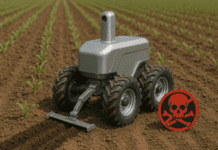This post is also available in:
 עברית (Hebrew)
עברית (Hebrew)
Supplying troops or rescue teams with the exact parts they need, exactly when they need them, has long been a logistical challenge. Damaged components, broken tools, or missing brackets can delay operations for hours or days, especially in remote or unstable environments where spare parts are impossible to source quickly. A new German-developed system aims to close that gap by taking manufacturing directly to the front line.
According to NextGenDefense, NEXOS.Group and CR-3D have introduced FieldRack, a mobile 3D printing platform built to operate in the same harsh conditions as the forces it supports. Instead of relying on fixed workshops, the printer places an industrial-grade additive manufacturing system onto a rugged, electric all-terrain chassis supplied by HAWE Mattro. The result is a self-contained fabrication unit that can travel across rough ground and produce mission-critical components on the spot.
The system is designed for situations in which traditional supply chains are disrupted, such as in disaster zones, high-risk areas, or isolated regions where transportation is limited. By carrying the printer to the point of need, the platform enables operators to fabricate replacement parts, adapt equipment, or create custom tools without waiting for resupply. For defense forces, this could significantly reduce downtime during operations, allowing units to repair gear or modify systems in response to rapidly changing battlefield conditions.
Because the printer can support “security-critical” use cases, it may appeal to military engineering teams, special operations units, or border security agencies that must remain self-sufficient far from established infrastructure. On-site additive manufacturing also has potential value for civil protection authorities handling earthquakes, floods, or industrial accidents where rapid technical fixes are essential.
The platform’s modular architecture allows the 3D printer, power systems, and mobility chassis to be upgraded independently. Its industrial printing module supports high-strength materials suited for tactical hardware, while the integration work ensures the system can link with external production lines, robotic cells, or other mobile systems where needed.
Unveiled at the Formnext 2025 trade show in Frankfurt, the printer reflects a broader shift in field logistics: pushing advanced manufacturing capabilities closer to those who require them. Instead of moving equipment to the workshop, the workshop now moves to the equipment — wherever that may be.


























